How to Make Your Own Zero-Waste Herbal Tea Blends
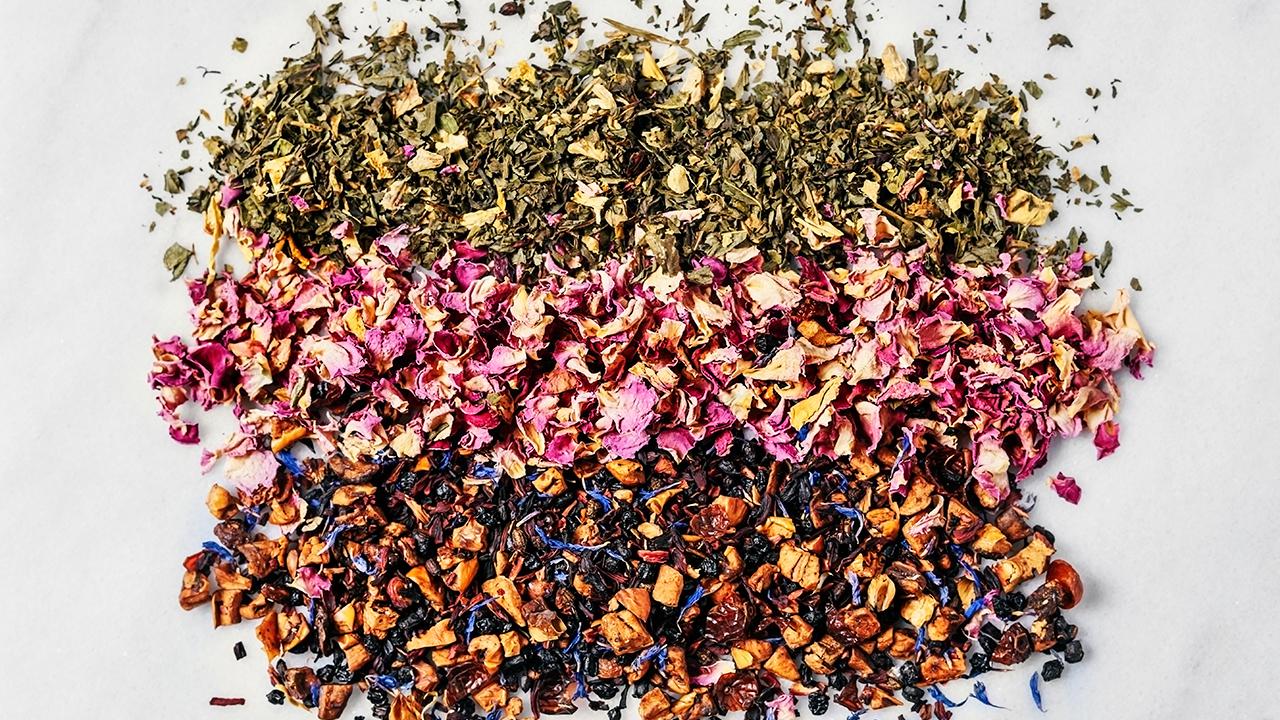
 Why you can trust us
Why you can trust us
Founded in 2005 as an Ohio-based environmental newspaper, EcoWatch is a digital platform dedicated to publishing quality, science-based content on environmental issues, causes, and solutions.
With a history dating back thousands of years, herbal tea has played an important role in ancient and modern cultures. Believed to have originated in China, tea has been brewed and revered for its health properties across the world.
Herbal tea is known to boost the immune system with its vitamins and antioxidants, improve digestion, fight colds, lower blood pressure, reduce inflammation, and relieve anxiety and stress.
Yet, the practices surrounding tea drinking have become increasingly wasteful. A study in the American Chemical Society’s Journal of Environmental Science and Technology found 11.6 billion microplastics (miniscule plastic particles) and 3.1 billion nanoplastics (1,000 times smaller than an algal cell) were released by a single plastic tea bag when brewed. Most teabags are now up to 25% plastic, using a plastic polymer to seal and maintain the shape of the bag when dipped into steaming water – even those marketed as paper tea bags.
The ingredients inside the tea bag also carry environmental concerns, including pesticide use for non-organic products, and the long distances ingredients must travel to get from the farm to your mug.
While plastic-free teabags can be tossed in the compost, there is an even more sustainable solution: making your own herbal tea.
Here are a few tips for getting started on creating your own blends from scratch.
Buying (or Growing) Your Herbs and Flowers
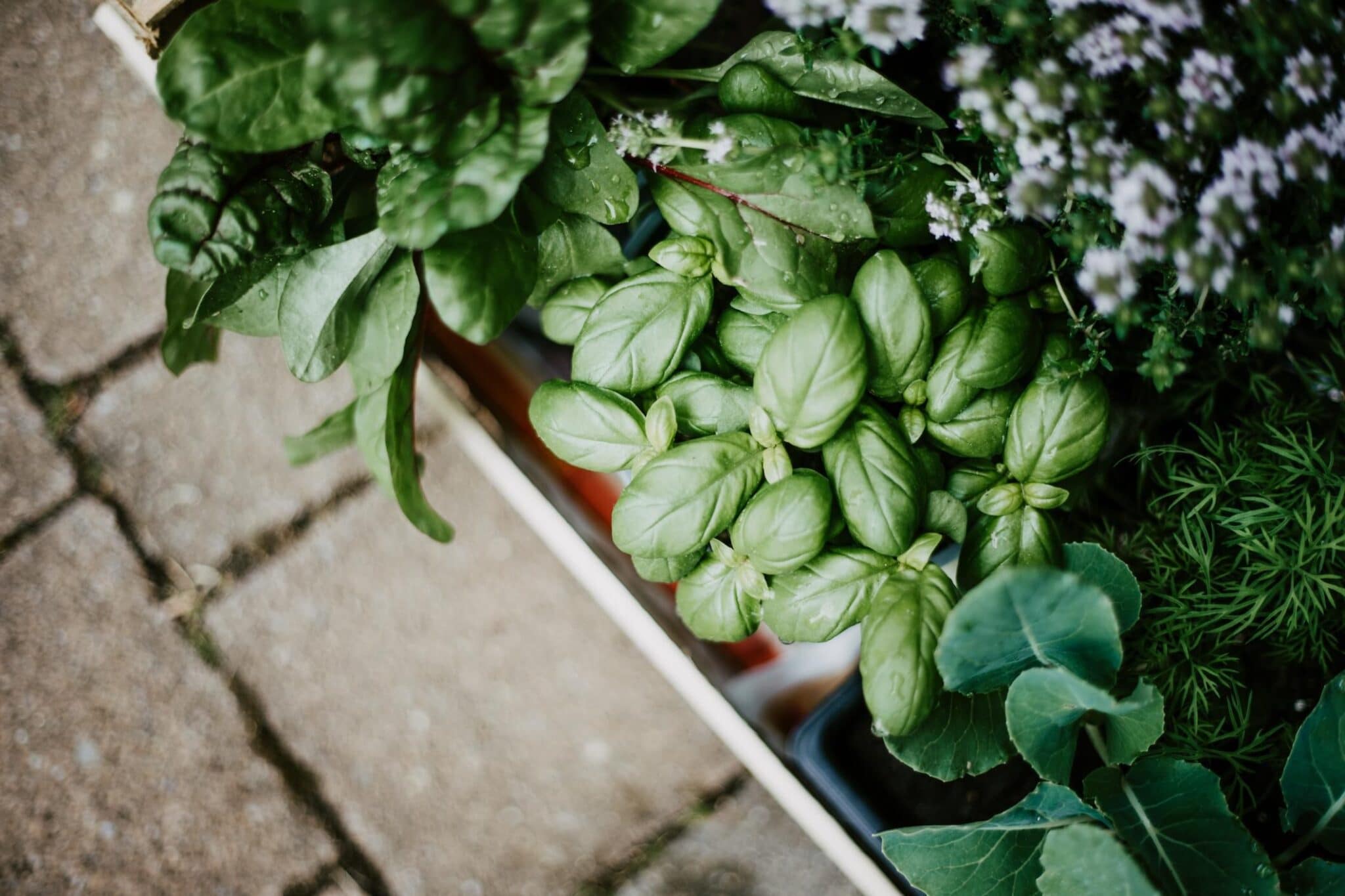
Lisa Schaetzle / Moment / Getty Images
Choose fresh, organic herbs from the grocery store – or, better yet, check out your local farmers market. If you have the space to grow your own herbs, however, you’ll save a great deal of plastic packaging and money by avoiding expensive store-bought herbs. Some of the most common herbs for tea are mint, lemon balm, lavender, basil, ginger, chamomile (a daisy-like herb that can be grown inside), rosemary, thyme, sage, jasmine, and lemongrass.
Luckily, you don’t need much room – or even any outdoor space – to grow your favorite herbs; a windowsill, sunny balcony, fire escape, or front stoop will do.
You can grow your herbs from seed, or purchase nursery plants (also known as starts) from a local grocery or garden store, or from a local farm. Fill pots that are between 6 and 12 inches deep with organic potting soil (normal garden soil will compress over time and leave little room for proper aeration), or space plants out in a long container. Plant seeds according to the instructions on the seed packet; usually, a few seeds should be placed on top of the soil and covered with a small amount of potting mix. The dirt should be kept moist until sprouts appear – covering the pots with plastic retains some humidity, so cover with a plastic bag if the soil seems to be drying out too quickly.
Alternatively, fill the bottom 2-3 inches of the pot with soil and carefully transfer nursery plants. Gently tease apart the roots and fill the remaining space with soil.
Make sure the plants are in a place where they’ll get at least six hours of sunlight a day, or provide a grow light to grow them anywhere in the house. Herbs should be watered only when the soil is dry an inch or two under the surface. Soil tends to dry out more quickly in the winter when heat is turned on, so they might need to be watered more frequently.
Many flower shops and grocery stores use pesticides or other chemicals to grow and preserve flowers, so if you want those floral notes in your tea, you’ll need to grow flowers on your own. Purchase seeds or starts for those you’d like to include, and grow in containers or in your garden; or, find pre-dried flowers at a grocery store if growing both herbs and flowers isn’t possible for you. Some local farmers might grow organic flowers that are safe to eat, but be sure to discuss this with farmers market vendors before purchasing.
Drying Fresh Herbs and Flowers
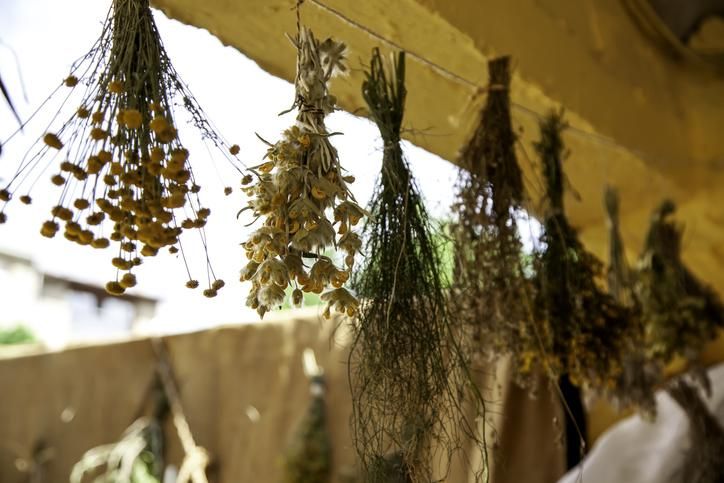
fotocelia / iStock / Getty Images Plus
Both fresh and dried herbs and flowers can be used to brew tea. If you aren’t ready to use your fresh ingredients right away, you’ll need to dry them before creating your blend.
Depending on the plant, there are four easy options for drying: air drying, or drying in an oven, microwave, or dehydrator.
First, if growing your own ingredients, harvest outdoor herbs and flowers in the mid-morning after the dew has dried, but when the sun isn’t too strong yet; you’ll want to harvest before the afternoon sun begins bleaching the essential oils out of the petals. If you’re air drying herbs with branches – like thyme, mint, basil, oregano, and rosemary – make sure to keep enough of the branch to hang them. Rinse the herbs carefully to remove dirt or insects, if necessary.
Air drying requires the least attention, but is considered one of the best options for preserving flavor. This method also takes a bit more time (anywhere from one to three weeks), and works best with thicker, waxier leaves, like rosemary. Gather the herbs with the cut branches facing the same direction, and bind together with rubber bands, string, or wire. To prevent dust or debris from gathering on the herbs – especially if you live in a dusty climate – wrap a paper bag with ventilation holes or cheesecloth around the bundle. Hang the herbs from the stems, preferably in a cool, dry room. Drying time varies based on humidity levels in your home; the herbs will dry much faster in dry climates. When they lose all pliability and easily break/crumble in your hand, they’re ready to be taken down, stripped from the branches, and stored.
If you’d rather speed up the process, drying herbs in the oven is a common and relatively easy method, but requires an oven that can be set at 135ºF. If the lowest setting on your appliance is higher than this, prop the door open slightly and monitor the temperature. The process can be pretty quick – often well under an hour – so keep an eye on the herbs and remove once they start to get crispy and crumble easily. If you’d rather use the microwave, wrap the herbs in paper towels and microwave for one minute. Allow the herbs to cool for 30 seconds, then microwave about for 30 seconds. Repeat this process until fully dry.
Dehydrators are expensive, but perhaps worth the investment if you’ll use it to dry more than just herbs. Lay the plants on the trays with some room between them, set the temperature to 135ºF, and allow to dry in the machine for about 12-24 hours. Let the dehydrator cool for a few hours before removing the herbs and storing.
If you’re adding flowers to your blend – like roses or hibiscus – clip the plant right underneath the crown of petals. Gently wipe the petals clean with a damp towel, spread on cheesecloth or a bamboo net, and place in direct sunlight. Place a cooling rack or something similar on top of the petals so they don’t blow away, and rotate them every few hours until completely dry. The petals should crumble off the crown easily. Soft-leafed herbs like mint, parsley, and basil can also be dried this way.
Store all dried herbs and flowers in airtight containers until you’re ready to use them.
Create Your Blend
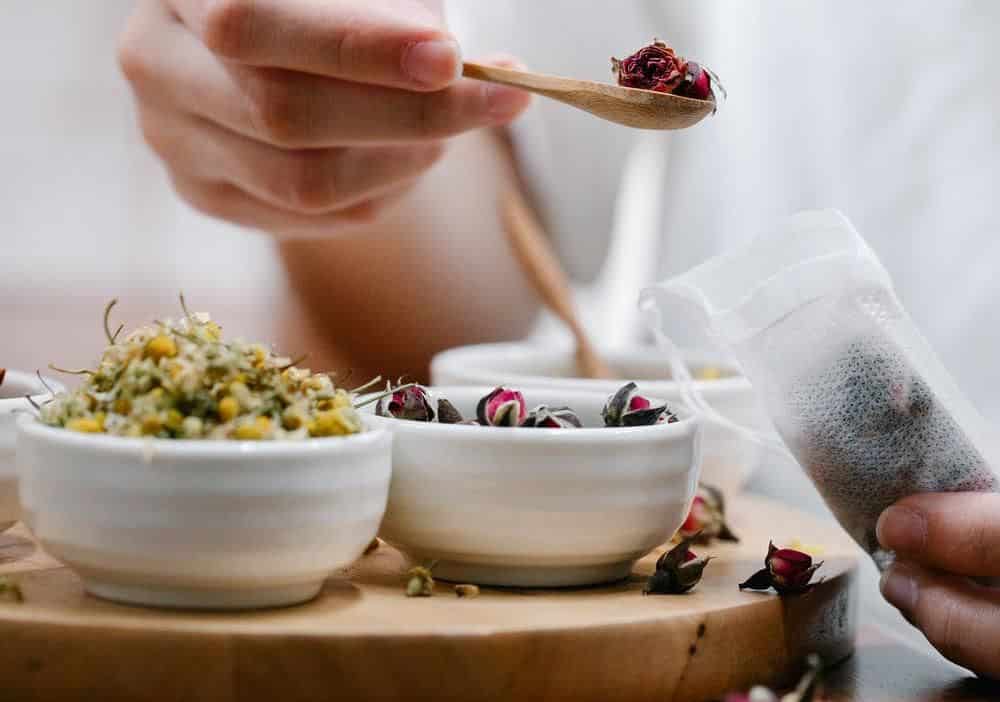
Pexels
Once you have your chosen herbs and flowers dried and ready, it’s time to create your tea blend. Dried blends have the advantage of longer shelf stability; if you’re using fresh ingredients, chop up the larger pieces if desired, mix them together, and use right away.
Most herbal teas follow a basic structure that employs three main flavors: a base (3 parts), compliment (1-2 parts), and an accent (1/2-1 parts). Create your own blends, or follow a recipe. For some sweetness or a citrusy punch, add honey and dried orange or lemon peels, or other spices from the cabinet like cinnamon, cardamom, cloves, peppercorn, cayenne, and turmeric.
For relaxation, try adding lavender, chamomile, lemon balm, or basil; for a cold, try lemon, ginger, honey, cloves, mint, cinnamon; and for supporting your immune system, include turmeric, lemongrass, hibiscus, peppermint, echinacea, or elderberry.
Here are a few ideas to start with:
- Chamomile, lavender, and mint
- Rosehips, lemongrass, lemon peel, and cinnamon
- Lemon verbena, thyme, and lemongrass leaves
- Chamomile, lemongrass leaves, and rose petals
- Mint, fennel seeds, and ginger
- Basil, chamomile, lemon balm, and lavender
- Fresh lemon, rosemary, and honey
- Orange or lemon peels, cardamom, and turmeric
Herbal blends can also be mixed with caffeinated tea; add black or green tea to the dried mixture for an extra kick.
Store blends in glass jars or another airtight container.
Tip: Homemade tea blends make great sustainable gifts!
Brew Your Tea
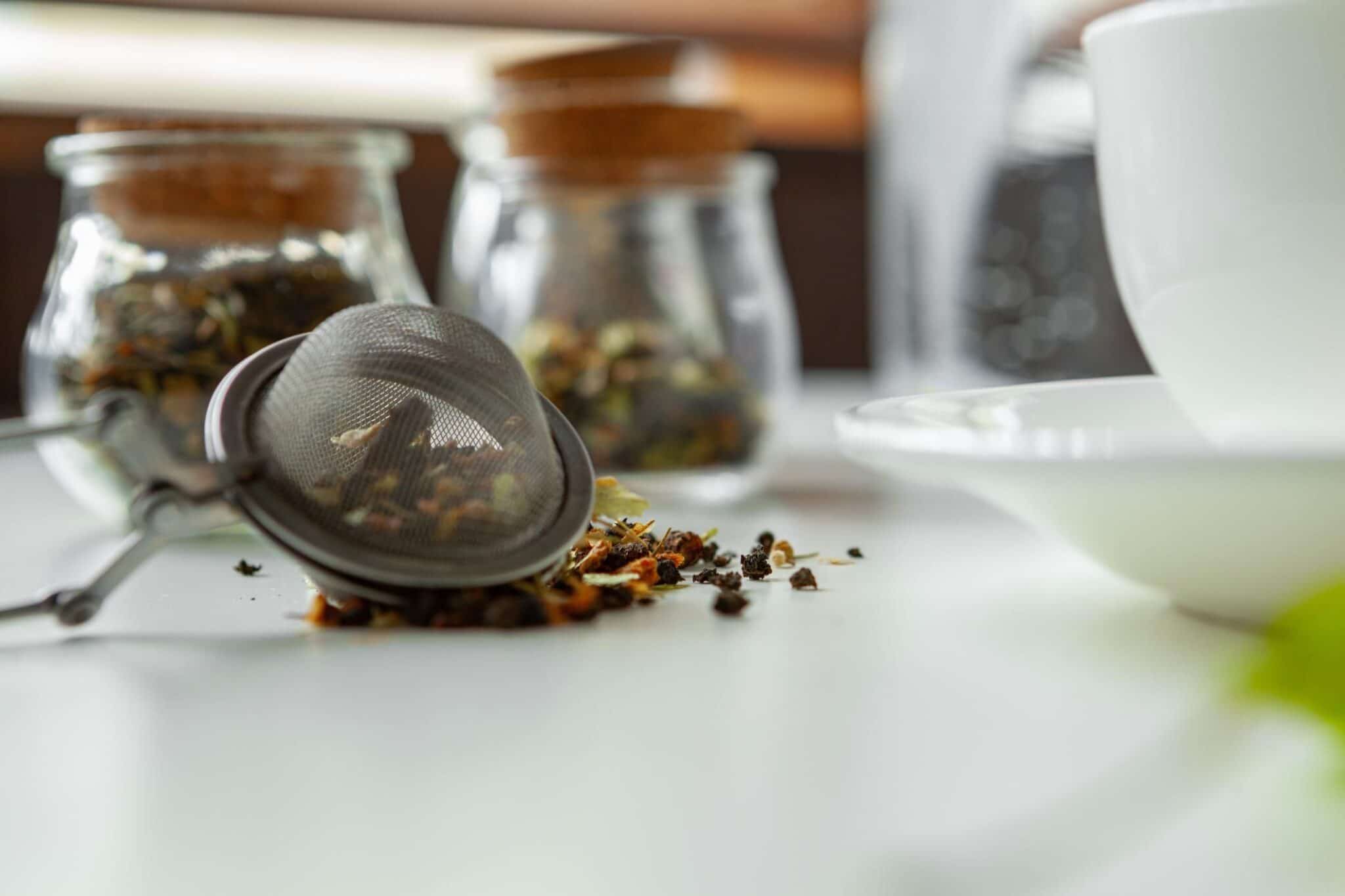
FabrikaCr / iStock / Getty Images Plus
Before brewing your new blend, consider your waste-free brewing options. Reusable linen tea bags can be washed and refilled, and act just like the single-use teabags we’re used to. Tea balls and infusers can also be filled with homemade tea – both fresh and dried – and are very easy to wash.
Whichever method you decide upon, add approximately 1 teaspoon of dried blend per cup of boiling water; for fresh ingredients, use 2 teaspoons per ¾ cup of water.
Steep dried tea for 3-5 minutes, or 5-10 for fresh. Stay on the shorter side for any blends you’ve added green, black, or other caffeinated tea to so the beverage doesn’t become bitter.
Enjoy!
Linnea graduated from Skidmore College in 2019 with a Bachelor’s degree in English and Environmental Studies, and now lives in Brooklyn, New York. Most recently, Linnea worked at Hunger Free America, and has interned with WHYY in Philadelphia, Saratoga Living Magazine, and the Sierra Club in Washington, DC.
Linnea enjoys hiking and spending time outdoors, reading, practicing her German, and volunteering on farms and gardens and for environmental justice efforts in her community. Along with journalism, she is also an essayist and writer of creative nonfiction.
Subscribe to get exclusive updates in our daily newsletter!
By signing up, you agree to the Terms of Use and Privacy Policy & to receive electronic communications from EcoWatch Media Group, which may include marketing promotions, advertisements and sponsored content.

 233k
233k  41k
41k  Subscribe
Subscribe 



